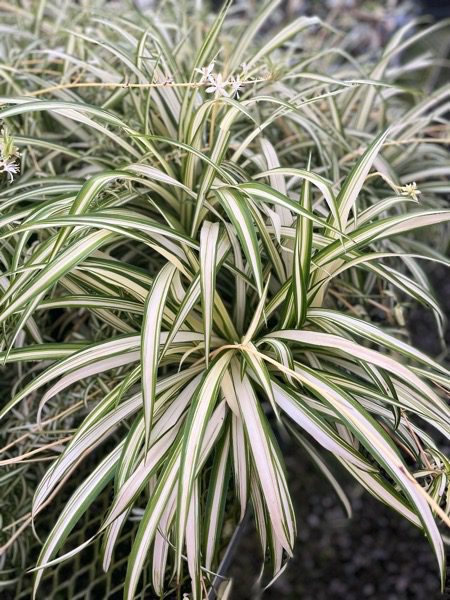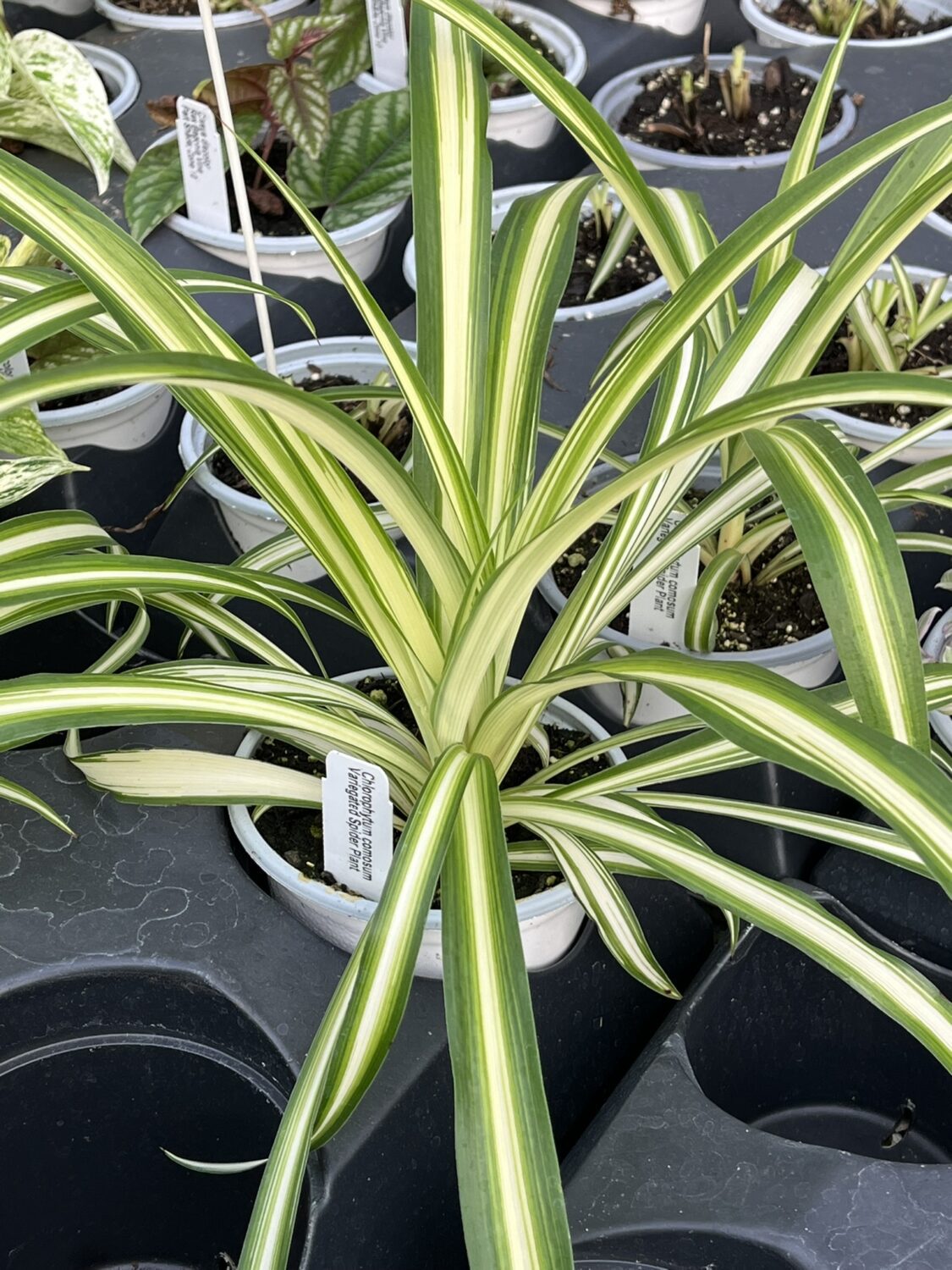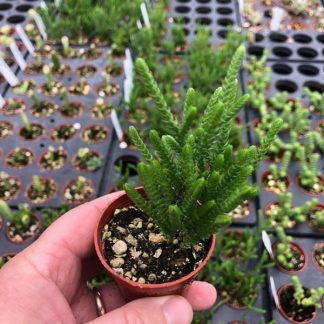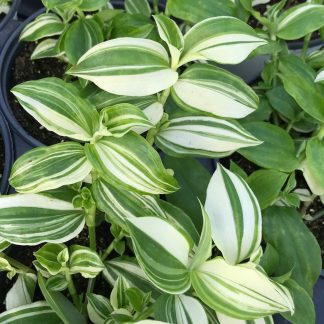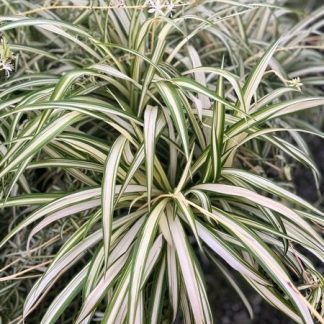Description
Variegated Spider Plant: A Lively Friend for Every Home
Description
Welcome to the world of the Variegated Spider Plant, Chlorophytum comosum. Picture arching leaves dressed in green and cream, spilling over the edge of a hanging basket like living ribbons. These leaves bend and dance, catching soft light in cozy corners and bright sun on cheerful windowsills.
This plant comes from the warm forests of South Africa, yet it feels right at home on our shelves and desks. In its natural home it grows under tall trees. There it enjoys dappled light, steady warmth, and gentle humidity. Released from the wild, it brings that calm, fresh energy into our living spaces.
The Variegated Spider Plant grows in tidy clumps. From each clump, thin stems stretch outward. At first they are lime green. Soon they lengthen and carry small white flowers that look like tiny stars. After the flowers fade, baby plantlets—“spiderettes”—appear. Hanging from their mother plant, they sway like little comets. In other words, your one plant becomes many with hardly any work at all.
People love this plant for more than looks. NASA once listed it among the top air-cleaning houseplants. It helps reduce indoor pollutants such as formaldehyde. So while it brightens a room, it also supports healthier breathing for all of us.
Another reason we adore it? It forgives our mistakes. Forget one watering? It bounces back. Give it bright light or light shade? It still shines. New gardeners gain confidence with it; seasoned gardeners keep it because it never stops giving.
Children often learn plant care by tending spider plants. Pets usually stay safe, too, because the leaves are non-toxic to cats and dogs. That means peace of mind when curious paws and little hands explore the greenery.
The variegated form offers many patterns. Some have creamy edges and green centers. Others flip the colors. Some display wider stripes; others look thin and precise. Each variety feels familiar yet fresh, giving us freedom to mix and match in creative displays.
Place one in a modern loft, a country kitchen, or a school library. It fits everywhere. When the thin stems tumble, they bring a playful spirit. Mount them high and watch friends look up in delight. Set one on a table, and the leaves sweep across the surface like a living fountain.
Above all, the Variegated Spider Plant invites us to slow down. We water, trim, and perhaps gift a baby plantlet to a neighbor. These small actions link us to nature and to one another.
How to Care for Your Variegated Spider Plant
Light: Bright but Gentle
Spider plants thrive in bright, indirect light. Place yours near a window with filtered sun, and the stripes will glow. Too little light turns leaves solid green. Too much direct sun may scorch them. Instead of harsh midday rays, aim for morning or late-day beams.
Tip: If the room is dim, move the pot closer to the window for part of the day. After more than one week you will see new white streaks emerge.
Water: Steady and Moderate
In their forest home, spider plants sip rain often yet never sit in puddles. We can copy that pattern. Water when the top inch of soil feels dry. Drench until water drains, then empty the saucer. This rhythm keeps roots moist but not soggy.
During winter growth slows. Check soil less often and water lightly. Yellow tips may warn of both overwatering and underwatering. Feel the soil first, then decide. But most of all, stay calm—this plant rebounds fast.
Soil: Light and Airy
Choose a well-draining potting mix. A blend for indoor foliage with added perlite works well. Roots like space to breathe, so avoid dense, heavy soils. If water sits on top, loosen the mix or repot.
Temperature and Humidity: Room-Friendly
Spider plants enjoy the same temperatures we do—between 60 °F and 80 °F. Keep them away from cold drafts and hot radiators. Average indoor humidity suits them fine, yet they smile at extra mist in dry winter months.
Feeding: Small Boosts
Feed with a balanced, water-soluble fertilizer at half strength every four weeks in spring and summer. Skip feeding in late fall and winter. Too much fertilizer can brown the leaf tips. Less is more.
Repotting: Every Two Years
Roots grow thick and may push against the pot wall. When you see them circling or rising above the soil, repot into a container one size larger. Spring is best, but anytime works if the plant feels tight. Fresh soil plus a bit of room sparks new growth.
Propagation: Fun and Simple
- Spot a spiderette: Choose a healthy baby plant with tiny roots.
- Snip and set: Cut the stem and tuck the baby into moist soil, or place it in water until roots grow longer.
- Wait and water: Keep soil lightly damp. In a few weeks the baby settles in, ready to start its own cascade.
Gift these babies to friends, trade them at plant swaps, or line sunny shelves with rows of new growth. In other words, one plant soon becomes a thriving community.
Common Problems and Quick Fixes
| Trouble | Likely Cause | Easy Solution |
|---|---|---|
| Brown leaf tips | Dry air, excess fertilizer, or chlorine in water | Trim tips, mist leaves, flush soil, or use filtered water |
| Pale leaves | Too little light | Move closer to gentle sun |
| Scorched patches | Intense direct sun | Provide sheer curtain or move east |
| Limp stems | Overwatering or root rot | Let soil dry, prune damaged roots, repot in fresh mix |
Styling Ideas
- Hanging Glory: Drop a basket from the ceiling. Let the plantlets trail like fireworks.
- Shelf Accent: Place on a high bookshelf; leaves will frame favorite novels.
- Green Curtain: Line several pots along a tall window ledge for a living valance.
- Desk Pal: Choose a compact cultivar for tight work spaces. Its calm look eases screen strain.
Instead of relying on plastic décor, use spider plants to soften hard edges and add movement. After more than a week you may notice your space feels lighter and more alive.
Companions That Shine Alongside
Spider plants pair well with pothos, philodendron, and peace lilies. They share similar light and water needs, forming a lush, layered display. Add a trailing string-of-pearls for contrast or a bright croton for bold color.
Family and Pet Friendly
Because the Variegated Spider Plant is non-toxic, children can explore its soft leaves without worry. Cats sometimes nibble the tips; if yours does, offer cat grass nearby to distract them.
Seasonal Care Snapshot
- Spring: Repot, start feeding, trim old leaves.
- Summer: Keep soil moist, watch for babies, share plantlets.
- Fall: Reduce feeding, clean dust from leaves for maximum light.
- Winter: Water less, avoid cold windows, enjoy its green cheer.
Why We Keep Coming Back
We live busy lives, but tending a Variegated Spider Plant slows our pace. We notice subtle changes—a new stripe, a fresh blossom, a playful baby plant. These moments teach patience and reward our care.
Over time we build traditions around this plant. Grandma’s spider plant may spill down for decades, each baby carrying shared stories. We may pass a rooted baby to a child’s teacher or a new neighbor. In those gifts we weave connection and kindness.
Growing this plant reminds us that beauty can be easy. We do not need rare equipment or fancy skills. With gentle light, clean water, and a little love, the plant returns joy many times over.
So invite one into your life. Let its arching leaves greet you each morning. Feel the calm it spreads through your space. And when friends admire its lively stripes, hand them a spiderette and share the secret: caring for plants is caring for ourselves.

